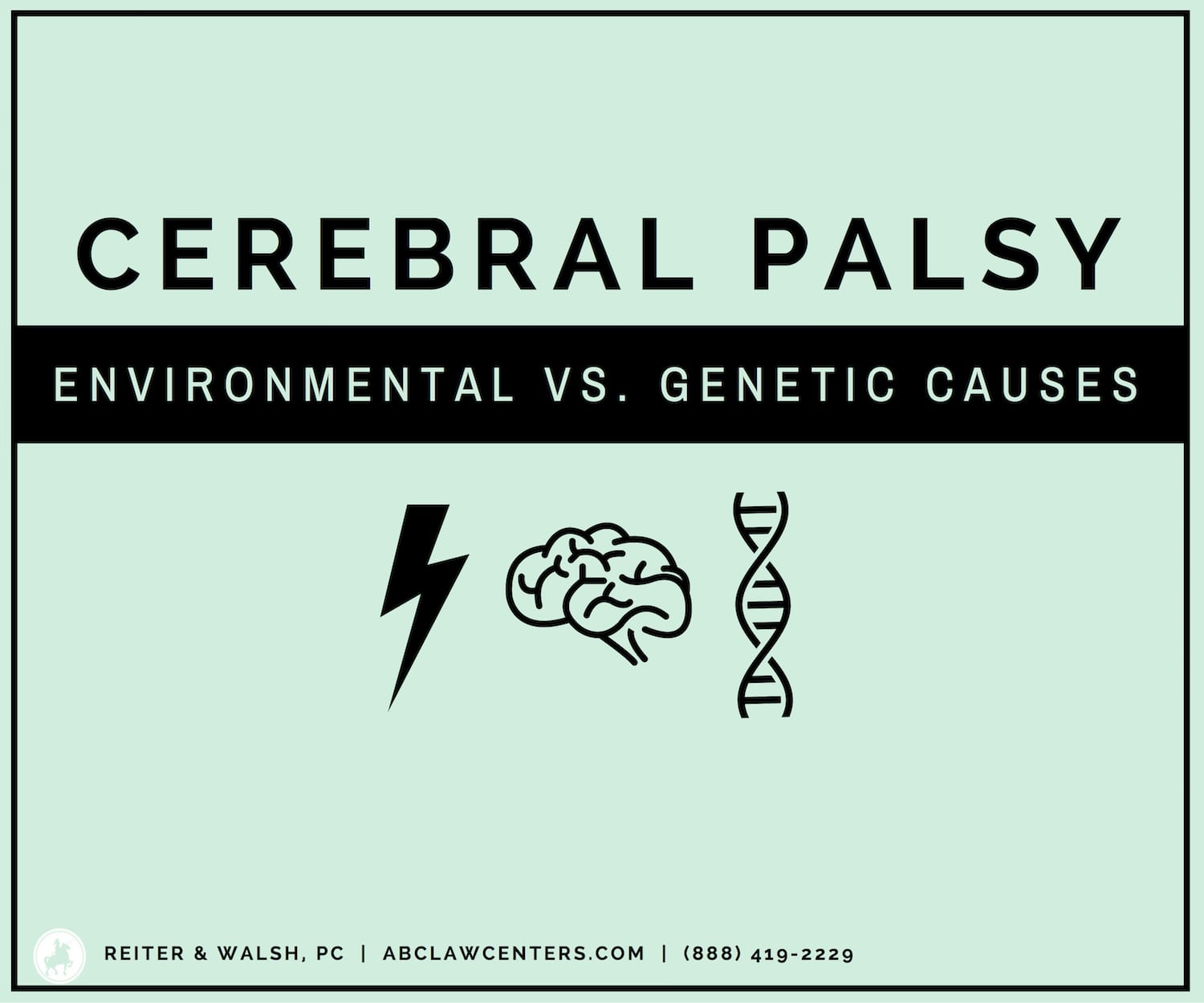Cerebral palsy is a diagnosis that varies in type and severity of neurodevelopmental outcomes. People with cerebral palsy have impaired motor function, and in some cases also have cognitive disabilities. Cerebral palsy can be caused by environmental and/or genetic factors.
Environmental causes of cerebral palsy
Cerebral palsy can often be attributed to something that goes wrong during pregnancy, delivery, or the neonatal period.
In many cases, it stems from birth asphyxia (oxygen deprivation around the time of birth). Birth asphyxia can also cause conditions such as hypoxic-ischemic encephalopathy and epilepsy, both of which frequently co-occur with cerebral palsy.
Cerebral palsy can also develop in children whose brains have been damaged by birth trauma or neonatal infections. Premature babies are more likely than term infants to develop cerebral palsy.
Many environmental causes of cerebral palsy are unfortunately linked to medical malpractice. For example, health care professionals may fail to monitor for and/or appropriately respond to signs of fetal distress. These are signs that a baby is being deprived of oxygen and is likely in need of an emergency C-section. Other problematic behaviors include deviating from the standard of care for a high-risk pregnancy, inducing labor when it is not safe to do so (drugs like Pitocin can be very risky), or using birth-assisting tools such as forceps and vacuum extractors when they are not indicated.
If a medical professional or organization behaved negligently, and this caused your child’s cerebral palsy, you may want to consult the birth injury attorneys at ABC Law Centers: Birth Injury Lawyers. We can help you seek justice for your child, and obtain financial compensation to cover lifelong treatment, therapy, and other expenses associated with cerebral palsy.
Genetic factors linked to cerebral palsy
Moreno-De-Luca et al. (2012) recently linked several genes to cerebral palsy, and noted that genetics may also predispose babies to known risk factors such as premature birth (1). Infants born prematurely are more strongly affected by environmental issues such as oxygen deprivation, trauma, and infection.
The national nonprofit United Cerebral Palsy (UCP) issued a statement (2) in response to the seminal paper by Moreno-De-Luca et al., saying that while their medical experts agree that cerebral palsy can sometimes be caused by genetic factors, much more research is needed into the specifics. UCP quotes Gai McMichael and Dr. Alastair H MacLennan, Australian experts on cerebral palsy and genetics:
“Although the article published in Lancet Neurology by Moreno-De-Luca et al. is important and extensive, to date one cannot yet say that large numbers of CP have a genetic origin. It would be inappropriate to suggest to families with a CP child that there are commercially available genetic tests to ascertain all the possible genetic variations that may or may not be associated with CP. It will take much more and expensive research to ascertain the percent of CP that has genetic origins and for us to be sure which genetic variations are truly pathogenic and responsible for the CP outcome. So although there are exciting horizons for genetic research in CP we cannot yet offer clinical tests or intervention and must advocate a conservative approach.”
Conclusion: genetic vs. environmental causes of cerebral palsy
Cerebral palsy is a complex disorder with a multitude of different causes. In some individuals, there may be both genetic and environmental factors at play. For example, genetic issues may predispose infants to a difficult birth (2), which could, in turn, lead to oxygen deprivation or head trauma. Moreover, certain mutations may make infants much more susceptible to infection, which can also cause cerebral palsy (3).
Although some rare genetic anomalies may make the development of cerebral palsy inevitable, a genetic predisposition to cerebral palsy does not necessarily mean that a child will develop it. As we gain new knowledge of how different genes can contribute to issues like prematurity and infection susceptibility, medical research will likely indicate preventative treatments for infants whose genes put them at high risk for developing cerebral palsy.
Even with our currently limited knowledge of genetic factors, there are many important measures that medical professionals can take to decrease the likelihood of a baby developing cerebral palsy. These include providing proper prenatal treatment and conducting indicated assessments, being vigilant for unexpected complications around the time of birth and prepared to intervene in an emergency, and promptly treating newborns with an issue like oxygen deprivation (see: hypothermia therapy) and infection.
If you suspect that your doctor or nurse failed to do these things, and your baby developed cerebral palsy as a result, you may want to consider a birth injury lawsuit. This can help you obtain the compensation needed to access the best treatments and other resources your child will need.
The attorneys at ABC Law Centers: Birth Injury Lawyers (Reiter & Walsh, P.C.) have decades of experience with cerebral palsy and birth injury cases. To find out if your child’s condition may be the result of medical malpractice, contact our firm for a free case review. We give personal attention to each child and family we help, and no fees are ever paid for any part of the legal process unless we win.
Free Case Review | Available 24/7 | No Fee Until We Win
Phone (toll-free): 866-995-2894
Press the Live Chat button on your browser
Complete Our Online Contact Form
Sources
- Moreno-De-Luca, Andres, David H. Ledbetter, and Christa L. Martin. “Genetic insights into the causes and classification of the cerebral palsies.” The lancet neurology 11.3 (2012): 283-292.
- “Genetics.” United Cerebral Palsy: Life without Limits for People with Disabilities, ucp.org/resources/from-the-medical-director-s-desk/genetics/.
- Kent, Athol. “Cerebral Palsy and Genetic Predisposition.” Reviews in Obstetrics and Gynecology 1.3 (2008): 148.
